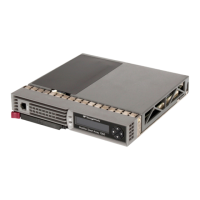40 Using the CLI
Host connection commands
Each time the MSA is powered on, all active HBA connections to the MSA are automatically detected and
identified by their WWPN.
Before a host accesses the storage of the MSA, you must identify the operating system (host mode) of each
connection. HP also recommends assigning a user-defined name to each connection, to make the
identification and setup of each connection easier.
After connections are established, be sure to restrict access to the LUNs to specific hosts. The CLI uses an
Access Control List (ACL) to enter the list of LUNs a host can access. See ”Access Control List commands”
on page 43 for more information about SSP and ACLs.
Each of the following commands is used to enter and manage the connections:
• Adding a connection
• Changing the profile of a connection
• Changing the user-defined name of a connection
• Deleting the user-defined name of a connection
• Creating a new profile
• Moving to a different profile
• Changing the profile mode
NOTE: Use the show connections command to display information about each HBA connected to the
MSA, including connection name, WWPN, and profile. See ”Show commands” on page 19 for an
example display.
Adding a connection
If the host is not yet connected to the MSA, but WWPN of the HBA is known, you can use this command to
manually add, name, and identify the connection.
Basic command
add connection <ConnectionName> <wwpn=xxxxxxxx-xxxxxxxx> [profile=profile_name]
[offset=offset_value]
Command options
ConnectionName—the user-defined name to give the connection, up to 16 alphanumeric characters.
wwpn=xxxxxxxx-xxxxxxxx—the WWPN of the active HBA inside the host attached to the MSA.
The show connections command can be used to obtain the WWPN.
profile=profile_name—the platform of the host. Options include:
Default—is not operating-system specific and should not be used; use a valid pre-defined name.
Windows
OpenVMS
Tru64
Linux
Solaris
Netware
HP
offset=offset_value—(default: 0) the unit offset for assigning logical volumes.
Example command and response
CLI> add connection MSA-1 wwpn=12345678-12345678 profile=windows
Connection MSA-1 has been added successfully.
Profile Windows is set for the new connection.

